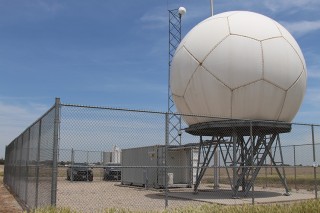

Image courtesy of the ARM Climate Research Facility (Flickr) via a Creative Commons License
Data collected from the Atmospheric Radiation Measurement Climate Research Facility’s Southern Great Plains site (shown here) was used to evaluate and compare climate model simulations of precipitation.
The Science
Precipitation is difficult to represent in global climate models. Although most single-column models can reproduce the observed average precipitation reasonably well, there are significant differences in their details, including mean precipitation intensity. Scientists evaluated the performance of seven single-column models, used by global models to complex processes, by comparing simulated surface precipitation with observations.
The Impact
The different single-column models’ performances and associations with large-scale conditions provide insights on how to improve climate models’ representation of convection, the movement of heat or air through fluids. Convection is integral to forming storm clouds. The insights gained here will also improve approaches for future testing.
Summary
Precipitation is one of the most poorly parameterized physical processes in global climate models. Scientists often use a single grid-box column of a global climate model or a single-column model to more efficiently study and test the process representations or parameterization schemes in global climate models. The single-column model approach is also a key strategy of the U.S. Department of Energy’s (DOE) Atmospheric Radiation Measurement (ARM) Climate Research Facility and Atmospheric System Research activity.
However, most single-column model intercomparison studies organized by ARM have been focused on special cases or week- to month-long periods. To make a statistically meaningful comparison and evaluation of modeled precipitation, researchers conducted 3-year-long single-column model simulations of seven global climate models participating in the Fast-physics System Testbed and Research (FASTER) project at the ARM Southern Great Plains site.
Results of the study, conducted by DOE scientists at Brookhaven National Laboratory, show that although most single column models can reproduce the observed average precipitation reasonably well, there are significant differences in their details.
These variations (both among models and between models and observations) include differences between daytime and nighttime, warm and cold seasons, frequency and mean precipitation intensity, and convective and stratiform partition. Further analysis reveals distinct meteorological backgrounds for large underestimation and overestimation precipitation events. The former occur in strong ascending regimes with negative low-level horizontal heat and moisture influx, while the latter occur in the weak or moderate ascending regimes with positive low-level horizontal heat and moisture influx.
Funding
This work is part of the FASTER project supported by the U.S. Department of Energy’s Earth System Modeling program.
Publication
H. Song, W. Lin, Y. Lin, A.B. Wolf, R. Neggers, L.J. Donner, A.D. Del Genio, Y. Liu, “Evaluation of precipitation simulated by seven SCMs against the ARM observations at the SGP site.” Journal of Climate 26 (15), 5467–5492 (2013). [DOI: 10.1175/JCLI-D-12-00263.1]














